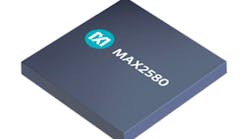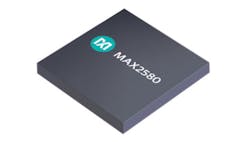Wireless communications has become so ingrained in modern life that most mobile wireless users have become virtual “moving offices.” Not only do their cellular telephones provide wireless conversations, but they are used for mobile data communications as well. Because of this steady growth in the use of wireless networks for data, more cell sites are needed, with wireless coverage that is reliably extended through the use of smaller cell sites—such as pico cells—both inside and outside of buildings.
Related Articles
• Emulator Takes LTE Testing Into The Real World
• Doherty Amp Boosts China’s LTE Signals
• UE Testing Eases Transition To VoLTE
For that reason, Maxim Integrated recently introduced its model MAX2580 RF transceiver integrated circuit (IC), a highly integrated single-chip radio that supports multiple wireless communications standards. It is ideally suited for multimode, multiple-input multiple-output (MIMO) radio designs, with support for all Third-Generation (3G), Long-Term-Evolution (LTE) cellular communications bands and modes.
The MAX2580 radio IC (see figure) is a tremendously versatile device, supporting all LTE wireless communications bands from Bands 1 to 41 with selectable channel bandwidths from 1.4 to 20.0 MHz. LTE Band 1, for example, operates within an uplink frequency range of 1920 to 1980 MHz and a downlink frequency range of 2110 to 2170 MHz. LTE Band 40 operates from 2300 to 2400 MHz, while LTE Band 41 resides within 2496 to 2690 MHz. The MAX2580 radio can also handle both frequency-division-duplex (FDD) and time-division-duplex (TDD) operation, since LTE Bands 1 through 25 operate with FDD while LTE Bands 33 to 43 employ TDD.
The MAX2580 is a highly integrated radio IC that can be programmed for a wide range of LTE/3G cellular standards and operating modes.
The radio IC requires very few external components to assembly an all-band, multimode, MIMO radio design. To assist designers, the MAX2580 design package includes full system-level reference designs to shorten time to market. Ideal for use in next-generation heterogeneous networks (HetNets), the MAX2580 is well suited for residential and enterprise indoor and outdoor picocell deployments. It features programmable channel bandwidths for all LTE/3G bands and modes. The radio IC integrates a complete 2 x 2 MIMO RF front end, with multiple receive and transmit mixers, receive and transmit frequency synthesizers, a clock-generation phase-locked loop (PLL), and generous amounts of data conversion. It includes intermediate-frequency (IF) amplifiers, fractional-N frequency synthesizers, high-speed data converters, and channel-selection filters.
The MAX2580 includes a standard JESD207 data interface for reliable connectivity with multicore LTE baseband processors, and its onboard power-amplifier (PA) predriver circuitry provides a level of 0 dBm for use with an additional transmit PA. According to Vickram Vathulya, Managing Director of RF Solutions at Maxim Integrated Products, “Maxim’s latest LTE/3G transceiver continues to showcase our relentless focus on delivering highly integrated and high-performance RF solutions for small-cell base stations.”
The MAX2580 radio IC was on display this past February at a leading mobile wireless trade show, the Mobile World Congress 2013 in Barcelona, Spain. At the event’s exhibition, Maxim teamed with leading semiconductor supplier Freescale Semiconductor to show a wireless picocell solution. The small-cell solution combined the MAX2580 transceiver with a Freescale model BSC9132 base-station system-on-a-chip (SoC) card, along with additional amplification and network management cards—all housed in a passively cooled enclosure weighing a mere 6.8 kg. The MAX2580 and the BSC9132 work together to form the heart of a complete multiple-band, multiple-standard, small cell site. The BSC9132 can process 64 simultaneous users, handling 150-Mb/s downlinks and 75-Mb/s uplinks in 20-MHz LTE FDD/TDD modes.
The MAX2580 transceiver IC is currently sampling to qualified customers and will be available in an 11 x 11 mm QFN package in the second half of 2013 to a larger audience.
MAXIM Integrated, 160 Rio Robles, San Jose, CA 95134; (408) 601-1000, www.maximintegrated.com.

